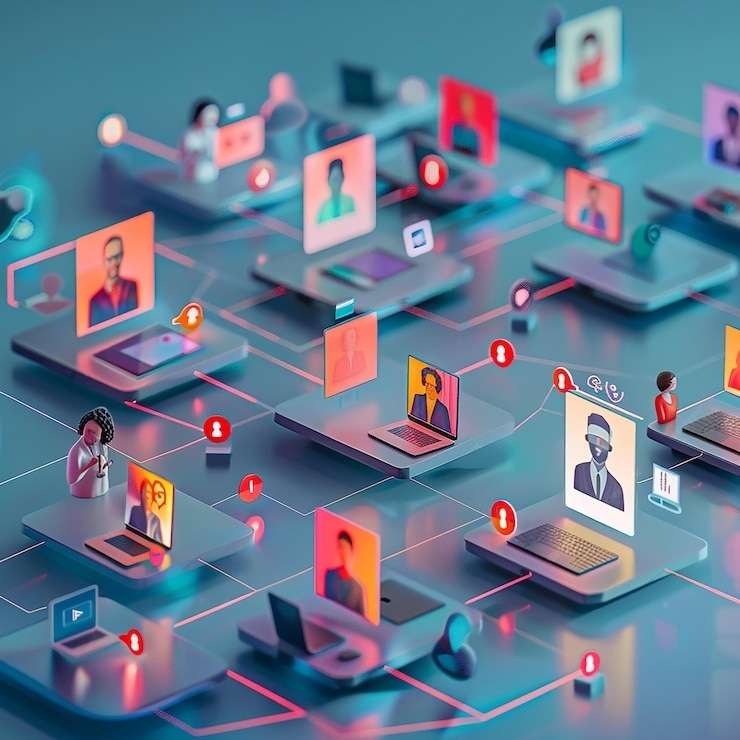One of LinkedIn’s most underutilized features is LinkedIn Groups, which can be a goldmine if used correctly. With the right strategy, you can leverage these groups to attract top-tier clients in your niche and boost your business significantly. In this comprehensive guide, we’ll explore how to use LinkedIn Groups effectively, step by step, to find high-paying clients. By the end, you’ll have actionable strategies that you can implement right away. Let’s start right away!

1. How to Find Relevant LinkedIn Groups for Your Niche
The Importance of Niche-Relevant Groups
Finding clients on LinkedIn is all about relevance. The more targeted your approach, the better your chances of connecting with high-paying clients. The key is to focus on LinkedIn Groups that align with your industry, expertise, and the kind of clients you want to attract. Not all groups are created equal—some may have thousands of members but are irrelevant to your field, while others may be smaller but filled with potential leads.
Step-by-Step Process to Identify Relevant Groups:
- Search by Keywords: Start by using specific keywords relevant to your niche. For example, if you’re a digital marketer, try keywords like “SEO”, “Content Marketing”, or “E-commerce Strategies.”
- Check Group Activity: Look for groups with active discussions. A large number of members doesn’t necessarily mean engagement. High activity shows a group is alive and worth your time.
- Examine Group Composition: Go through the members list. Are there decision-makers, business owners, or people likely to hire you? Avoid groups filled with competitors or spam accounts.
- Consider Joining Industry Associations’ Groups: Many industry associations have official LinkedIn Groups, which are often filled with professionals in need of services.
Tools to Aid Your Search:
- LinkedIn’s Own Search Filters: Use the “Groups” filter in LinkedIn’s search bar.
- Grouply.io: A third-party tool that helps find niche LinkedIn Groups based on keywords.
2. Joining LinkedIn Groups: Best Practices for Client Acquisition
How to Join the Right Groups
Once you’ve identified relevant groups, joining is the next step. But simply being in a group won’t land you high-paying clients; it’s about your approach.
Best Practices:
- Complete Your Profile First: Make sure your LinkedIn profile is optimized to clearly showcase your expertise and the value you offer. When people check your profile after group interactions, they should immediately see why they should work with you.
- Read Group Guidelines: Each group has its own set of rules. Breaking these will make you appear unprofessional and could get you kicked out, losing access to valuable connections.
- Introduce Yourself Thoughtfully: When you first join, post a short introduction. Don’t just say “Hi, I’m John.” Instead, offer something useful: “Hi, I’m John, a content strategist helping startups create engaging content. If you’re a founder or a content manager, I’d love to connect!”
3. How to Engage Effectively in LinkedIn Groups
The Power of Engagement
Engaging meaningfully in LinkedIn Groups is where the magic happens. It’s not about hard-selling but rather building trust, credibility, and positioning yourself as an authority.
How to Engage for Maximum Impact:
- Comment on Existing Discussions: This is the easiest way to get started. Look for discussions where your expertise is relevant, and contribute insights. Avoid generic responses like “I agree.” Instead, add value with examples, data, or a unique perspective.
- Ask Thought-Provoking Questions: Asking questions is one of the best ways to drive engagement. For example, “What’s been the most challenging aspect of digital transformation in your company?” invites thoughtful responses and shows your interest in others’ experiences.
- Post Case Studies or Success Stories: Share how you’ve helped clients solve problems. This not only highlights your skills but also attracts potential clients facing similar issues.
4. The Role of LinkedIn Group Rules and Etiquette in Client Attraction
Why Etiquette Matters
Every LinkedIn Group has rules that keep the space organized and productive. Following these rules isn’t just about avoiding a ban; it’s about building a professional reputation.
Key Etiquette Practices:
- Avoid Self-Promotion (at least initially): The fastest way to alienate group members is to start by promoting your services. Focus on being helpful first.
- Respect Differing Opinions: LinkedIn Groups are filled with professionals from different backgrounds. Disagree respectfully and provide constructive feedback.
- Be Consistent: Engage regularly rather than sporadically. This will keep you top of mind for members who may need your services in the future.
5. How to Identify High-Paying Clients in LinkedIn Groups
Qualities of High-Paying Clients
Not every potential client in a LinkedIn Group will have the budget or the need for your services. You need to identify high-paying clients based on certain markers:
- Job Titles: Look for business owners, C-level executives, or heads of departments. These individuals usually have hiring power and a budget.
- Engagement Level: High-paying clients are often active in discussions and regularly share their own insights. They may even mention challenges that your services could solve.
- Profile Indicators: Check their LinkedIn profiles for company size, growth trends, and past hiring behaviors. Larger companies or fast-growing startups are more likely to invest in premium services.
6. Creating Your Own LinkedIn Group to Attract Clients
Why Create Your Own Group?
Starting your own LinkedIn Group gives you control over the discussions, membership, and group culture. More importantly, it positions you as a leader in your niche.
Steps to Create a High-Value LinkedIn Group:
- Define Your Group’s Purpose: What specific problem will your group solve for members? Make it crystal clear in the group description.
- Invite Industry Influencers: Attract key figures to join early on. Their presence can draw more members and lend credibility to your group.
- Foster a Collaborative Culture: Set the tone for collaboration and learning, rather than just self-promotion.
7. How to Promote Your LinkedIn Group to the Right Audience
Promotion Strategies That Work
Once your group is live, the next challenge is attracting the right people. The goal is to build a community of engaged, high-paying clients.
How to Promote Effectively:
- Leverage Your Existing Network: Invite connections who would benefit from the group. Ask them to invite their network as well.
- Use LinkedIn Ads: If you have a budget, you can target specific demographics with LinkedIn Ads to attract members to your group.
- Share in Other Relevant Groups: Be mindful of group rules, but sharing your new group in complementary LinkedIn Groups can help gain traction.
8. Leveraging LinkedIn Group Insights to Understand Your Audience
Using Group Insights for Better Engagement
LinkedIn provides detailed analytics for group owners, offering valuable insights into what content resonates and who’s engaging. This data is gold when it comes to refining your group strategy.
Key Metrics to Track:
- Engagement Rate: How many members are actively participating in discussions? If engagement is low, consider changing your content strategy.
- Member Growth: Are new members joining consistently? If growth stalls, it might be time to ramp up promotion.
- Top Contributors: Identify the most active members and nurture these relationships, as they’re likely potential clients or great referrers.
9. How to Provide Value in LinkedIn Groups to Build Trust
Why Value is the Currency of Trust
To convert group members into high-paying clients, you first need to establish trust. And trust comes from consistently providing value without asking for anything in return. When you offer insights, solutions, and support, you position yourself as a reliable expert—someone people will want to work with when the time comes.
Ways to Provide Value:
- Answer Questions Thoughtfully: In most LinkedIn Groups, members regularly ask for advice or share challenges. Instead of generic replies, offer detailed, actionable solutions that reflect your expertise. For example, if someone asks how to improve their website’s SEO, go beyond the basics and suggest specific tools or strategies.
- Share Useful Resources: Providing links to free tools, articles, or whitepapers related to your niche shows that you’re invested in helping others succeed. If you’ve written blogs or case studies, sharing them sparingly (and only when relevant) can demonstrate your knowledge without coming across as self-promotional.
- Offer Free Consultations or Audits: Occasionally offering a free service, like a 15-minute consultation or a mini audit, is a great way to build relationships. High-paying clients often start with free value before committing to a paid service.
- Host Webinars or Q&A Sessions: Organize educational webinars or virtual meetups within the group. You can cover industry trends, common challenges, or niche-specific insights. Not only do these events provide immense value, but they also showcase your expertise to a live audience.
- Celebrate Wins of Group Members: If you notice group members sharing personal or business achievements, congratulate them. It fosters a positive community culture, shows you care, and positions you as someone who values relationships over transactions.
10. Using LinkedIn Group Discussions to Showcase Expertise
Show, Don’t Tell
Instead of telling everyone you’re an expert, show them. LinkedIn Groups are the perfect venue for you to subtly highlight your skills and expertise. The goal is to showcase your knowledge in a way that feels natural and helpful to group members.
How to Use Discussions for Maximum Impact:
- Start High-Value Conversations: Don’t wait for others to initiate discussions. Proactively start conversations around common pain points in your industry. For instance, if you’re a financial advisor, start a discussion on “Best Investment Strategies in a Recession” or “How to Secure Funding for Startups.” Thought-provoking discussions like these attract high-level engagement and position you as a go-to expert.
- Share Case Studies: Group discussions are a great place to share your own case studies or success stories. Frame it in a way that offers value to the group, such as: “Here’s how I helped a client reduce operational costs by 30%. Would love to hear your thoughts on similar strategies.” This gives you a chance to demonstrate your experience while engaging in a broader conversation.
- Answer Questions with Authority: Whenever someone asks for advice or a solution, reply with confidence and authority. Offer a well-researched, thoughtful response that shows you know what you’re talking about. This helps build your reputation as the group’s go-to expert.
11. How to Network with Group Members to Establish Connections
Building Real Relationships
The secret to finding high-paying clients on LinkedIn Groups isn’t in aggressively pitching services. It’s in building real, meaningful relationships. When group members feel like they know and trust you, they’ll be more inclined to reach out when they need your services.
Strategies for Effective Networking:
- Send Personalized Connection Requests: After engaging with a member in a group discussion, send them a connection request with a personalized note. Mention the conversation and express your interest in staying connected. For example, “Hi Sarah, I enjoyed your insights on the recent LinkedIn Group discussion about content marketing strategies. I’d love to connect and continue learning from you.”
- Take Conversations to Direct Messages: Once you’ve interacted with someone multiple times in group discussions, you can move the conversation to direct messages. Don’t sell immediately—focus on getting to know the person, their needs, and how you can help.
- Offer Help Before Asking for Anything: Whether it’s providing a resource, introducing them to someone in your network, or offering advice, show you’re genuinely interested in helping. When you lead with generosity, you naturally build stronger relationships.
12. The Benefits of Hosting LinkedIn Group Events
Why Group Events Are a Game-Changer
Hosting events within LinkedIn Groups is one of the most effective ways to build authority and attract high-paying clients. Events—whether webinars, live Q&A sessions, or virtual workshops—allow you to interact with potential clients in real-time, answering their questions and offering valuable insights.
Key Benefits of Hosting Events:
- Instant Credibility: Hosting an event immediately positions you as a leader in your field. People associate authority with those who take the initiative to lead discussions or share knowledge.
- Direct Access to Decision-Makers: Events attract high-level professionals looking for solutions. When you provide value during an event, attendees are more likely to consider you when they’re ready to hire.
- Showcasing Your Skills in Real-Time: Hosting a live event lets you demonstrate your expertise in an interactive environment. It’s an opportunity to offer real-time solutions, showcase case studies, or even conduct live demonstrations.
13. How to Share Content in LinkedIn Groups Without Spamming
The Right Way to Share Content
Sharing content is essential, but doing it incorrectly can lead to being perceived as spammy. You want your content to be welcomed by the group, not ignored or flagged by moderators.
Best Practices for Sharing:
- Make It Contextual: Always ensure your content is relevant to the ongoing discussion or the group’s purpose. If a member asks a question about digital marketing, and you have a blog post that addresses their concern, that’s the perfect time to share it. Adding context like, “Here’s an article I wrote that might help answer your question,” makes it feel more personal and less promotional.
- Engage First, Share Later: Don’t make sharing content the first thing you do in a group. Engage with other members’ posts and comments, contribute to discussions, and build rapport first. Then, when you share content, it feels more like a natural contribution.
- Limit Frequency: Sharing content too often can be perceived as aggressive marketing. A good rule of thumb is to contribute helpful insights or comments in 4–5 discussions for every one piece of content you share.
14. Using LinkedIn Groups for Market Research and Client Discovery
Tapping into Group Knowledge
LinkedIn Groups can double as a goldmine for market research. By observing conversations, asking questions, and engaging in discussions, you can gather valuable insights into your target audience’s pain points, needs, and preferences.
How to Conduct Market Research:
- Survey Group Members: If the group rules allow, you can create polls or surveys to ask members about their challenges, goals, or current solutions. This can help you better understand their needs and tailor your services accordingly.
- Monitor Trending Topics: Pay attention to which topics spark the most engagement. What are people asking about or struggling with? The answers can help you identify what your potential clients are looking for.
- Analyze Competitors: LinkedIn Groups often include your competitors. By observing their interactions, you can gain insights into their strategies, pricing, and service offerings. This can help you refine your own approach to stand out.
15. How to Moderate a LinkedIn Group for Maximum Engagement
The Role of a Group Moderator
If you’re running your own LinkedIn Group, moderation is key to keeping it active and valuable. A well-moderated group attracts high-paying clients by maintaining a balance between engagement and professionalism.
Moderation Strategies:
- Set Clear Group Rules: Establish guidelines that foster constructive discussions and prevent spam. Pin the rules to the top of the group so members know what’s expected.
- Encourage Participation: Keep the group active by asking thought-provoking questions, posting discussion prompts, and encouraging members to share their experiences.
- Enforce Rules Consistently: If someone breaks the rules—such as spamming or being disrespectful—take action quickly. Removing problematic members preserves the group’s integrity and keeps it a positive space.
16. LinkedIn Group Analytics: Tracking Your Group’s Success
Why Analytics Matter
LinkedIn Group analytics provide insights into what’s working and what isn’t. Tracking engagement levels, membership growth, and the types of content that get the most interaction will help you fine-tune your group strategy.
Key Metrics to Track:
- Engagement Rate: How many members are actively participating? Low engagement means you may need to adjust your content strategy.
- Top Contributors: Identify members who contribute the most and consider rewarding or spotlighting them to encourage more participation.
Content Performance: What types of posts get the most likes, comments, or shares? Use this data to create more of what your audience enjoys.
17. How to Collaborate with Other LinkedIn Groups for Client Acquisition
The Power of Collaboration
Collaborating with other LinkedIn Groups can significantly expand your reach and increase your chances of finding high-paying clients. By forming partnerships with groups that share a similar target audience but aren’t direct competitors, you open up new opportunities to engage with a wider community and establish yourself as an expert in a broader space.
How to Find the Right Groups for Collaboration:
- Research Complementary Groups: Look for groups that serve your industry but focus on different aspects. For example, if you’re a digital marketer, a collaboration with a group focused on content creation or business growth would be a natural fit.
- Engage First: Before proposing a collaboration, spend time engaging in the group. Comment on posts, provide value, and build rapport with both the group members and the group owner. This will make your collaboration pitch more natural and well-received.
- Reach Out to Group Admins: Once you’ve established a presence, reach out to the admins or group leaders and propose a mutually beneficial collaboration. This could be co-hosting a webinar, sharing content between groups, or organizing joint group discussions.
Benefits of Group Collaboration:
- Expands Your Audience: By tapping into another group’s member base, you get exposure to potential clients who may not have discovered your services otherwise.
- Increases Credibility: When a trusted group collaborates with you, their members are more likely to trust your expertise, giving you immediate credibility.
- Diversifies Engagement: Collaboration can introduce fresh perspectives and discussions, keeping both groups active and engaged.
18. Building a Strong Community in Your LinkedIn Group
Why Community Matters
The most successful LinkedIn Groups aren’t just collections of people—they’re thriving communities. High-paying clients are more likely to emerge from a community where members feel valued, supported, and engaged.
Steps to Build a Strong Community:
- Create a Welcoming Environment: From the moment someone joins, they should feel welcome. Send personalized welcome messages to new members, introduce them to the group, and encourage them to participate in ongoing discussions.
- Foster Genuine Connections: Encourage members to introduce themselves, share their stories, and ask questions. The more people feel like they’re part of something meaningful, the more they’ll engage.
- Reward Contributions: Recognize and reward active members who contribute positively. Whether it’s spotlighting them in a post or offering a free consultation, showing appreciation for their contributions will foster loyalty and encourage others to participate more.
- Consistent Interaction: As a group owner or active member, your consistent presence is key. Reply to posts, initiate conversations, and keep the group’s energy positive and constructive.
Tools to Keep Engagement High:
- Polls and Surveys: Use polls to ask for opinions, get feedback, or spark discussions.
- Challenges and Contests: Organize group challenges related to your niche, such as a “30-day marketing improvement challenge.” It gets people involved and drives engagement.
- Virtual Events: Hosting regular webinars or Q&A sessions will give members something to look forward to and provide a platform for real-time interaction.
19. Strategies for Re-Engaging Dormant LinkedIn Group Members
Reviving Inactive Members
Every group goes through periods where engagement slows down. Dormant members represent a missed opportunity—reviving their interest can re-energize the group and bring back potential high-paying clients.
Tactics to Re-Engage Dormant Members:
- Send Personalized Messages: Reach out to inactive members with a personalized message, inviting them to participate in a new discussion or event. Mention any updates or changes in the group that may interest them.
- Start Fresh Conversations: Launch a fresh, thought-provoking discussion around current trends, industry challenges, or solutions. Sometimes, dormant members are simply waiting for a topic that resonates with them.
- Create Exclusive Offers: Give dormant members a reason to return by offering something exclusive, like a free ebook, consultation, or access to a private webinar. Exclusive offers signal value and urgency.
- Highlight Group Success: Sharing success stories of members who’ve benefitted from the group can inspire inactive members to re-engage, especially if they see tangible outcomes, such as new clients or business growth.
20. Case Studies: Success Stories of Client Acquisition through LinkedIn Groups
Real-Life Examples of Success
There’s no better way to showcase the power of LinkedIn Groups than through real-life success stories. Below are case studies of individuals and businesses that have successfully used LinkedIn Groups to attract high-paying clients.
Case Study 1: From Group Member to $10,000 Client in 3 Months
Industry: Marketing Consultancy
Sarah, a marketing consultant, joined a LinkedIn Group focused on helping small businesses grow through digital marketing. For the first month, she actively engaged in group discussions, answering questions and offering free advice. One business owner, impressed by her insights, reached out privately for a consultation. Three months later, after a series of free consultations and continued engagement, Sarah landed a $10,000 contract to revamp the business’s entire marketing strategy.
Case Study 2: Building a Six-Figure Business by Hosting a LinkedIn Group
Industry: Financial Planning
John, a financial planner, noticed a gap in the market for comprehensive financial advice for millennials. He created a LinkedIn Group focused on this niche, regularly posting content, hosting webinars, and engaging members. Over time, the group grew to 2,000 active members, many of whom were entrepreneurs or young professionals in need of financial guidance. Through consistent engagement and networking, John converted several group members into long-term clients, building a six-figure business within two years.
Case Study 3: Collaborating with a LinkedIn Group to Land High-Paying Clients
Industry: Software Development
Lisa, a software developer, collaborated with the admin of a LinkedIn Group for tech entrepreneurs to host a webinar on “Best Practices for Building Scalable Apps.” The webinar attracted over 100 attendees, many of whom were startup founders. By offering practical advice and demonstrating her expertise, Lisa gained three new clients who needed app development services, each paying over $20,000 for her services.
Conclusion: The Power of LinkedIn Groups in Client Acquisition
LinkedIn Groups offer a unique and powerful platform for professionals to connect with high-paying clients. By engaging meaningfully, building trust, and providing consistent value, you can turn group members into loyal clients without the need for aggressive sales tactics. The key is to focus on creating authentic relationships, sharing your expertise, and staying active within the community. Whether you’re participating in existing groups or building your own, LinkedIn Groups can be a goldmine for business growth when approached strategically.
By using the strategies outlined in this article—such as identifying high-paying clients, engaging in discussions, collaborating with other groups, and hosting events—you’ll be well on your way to harnessing the full potential of LinkedIn Groups and transforming your professional network into a thriving client base.















